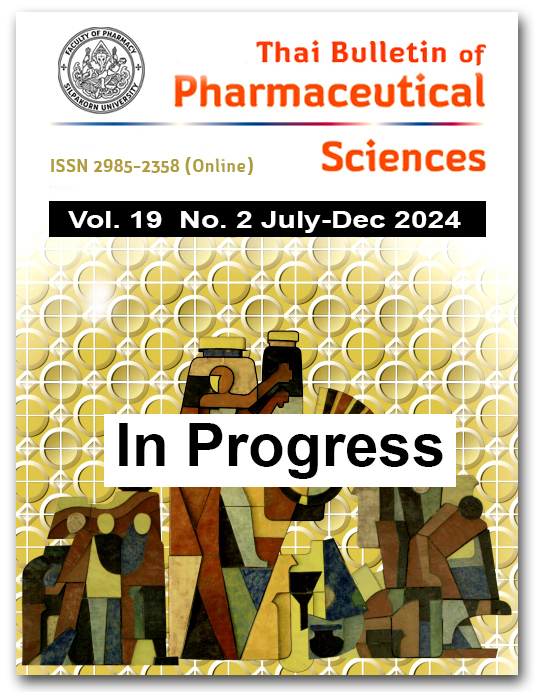DEVELOPMENT OF A PAPER-BASED DEVICE USING INDOXYL ACETATE AS A CHROMOGENIC SUBSTRATE FOR RAPID QUALITATIVE DETERMINATION OF LIPASE INHIBITOR
DOI:
https://doi.org/10.69598/tbps.19.2.177-183Keywords:
paper-based device, lipase inhibitor, indoxyl acetate, orlistatAbstract
An improved paper-based device using indoxyl acetate as a chromogenic substrate was developed for rapid qualitative determination of lipase inhibitory activity. Colorless indoxyl acetate can be catalytically hydrolyzed by lipase to produce the blue-colored indigo dimer on the paper device. In the presence of a lipase inhibitor, enzyme activity diminishes, resulting in reduced hydrolysis of indoxyl acetate. Consequently, this leads to a decrease in the intensity of the blue coloration, which can be visually observed across a range of blue shades and analyzed using image analysis. Orlistat was used as the representative lipase inhibitor in the assay. The LODs obtained from visual detection and the image analysis were comparable. The paper-based device using indoxyl acetate for lipase inhibition assay was simple and convenient. It could be useful as a simple screening method for the detection of orlistat adulteration in weight loss supplements.
References
Liu TT, Liu XT, Chen QX, Shi Y. Lipase inhibitors for obesity: A review. Biomed Pharmacother. 2020;128:110314.
Lunagariya NA, Patel NK, Jagtap SC, Bhutani KK. Inhibitors of pancreatic lipase: State of the art and clinical perspectives. EXCLI J. 2014;13:897-921.
Shimura S, Tsuzuki W, Suzuki T. Determination of lipase activity in organic solvent using fluorescent substrate and its application to the screening of lipase inhibitor. Anal Sci. 1991;7:15–8.
Yasser B, Issa A, Mohammad M, Hudaib M, Tawaha K, Alkhatib H, Almasri I, Bashar A. Inhibition of hormone sensitive lipase and pancreatic lipase by Rosmarinus officinalis extract and selected phenolic constituents. J Med Plant Res. 2010;4(21):2235-42.
Martinez-Gonzalez AI, Alvarez-Parrilla E, Díaz-Sánchez ÁG, de la Rosa LA, Núñez-Gastélum JA, Vazquez-Flores AA, Gonzalez-Aguilar GA. In vitro inhibition of pancreatic lipase by polyphenols: A kinetic, fluorescence spectroscopy and molecular docking study. Food Technol Biotechnol. 2017;55(4):519-30.
Bayineni VK, Suresh S, Singh G, Kadeppagari RK. Development of a bioautographic method for the detection of lipase inhibitors. Biochem Biophys Res Commun. 2014;453(4):784-6.
Hassan AMS. TLC bioautographic method for detecting lipase inhibitors. Phytochem Anal. 2012;23(4):405-7.
Tang J, Zhou J, Tang Q, Wua T, Cheng Z. A new TLC bioautographic assay for qualitative and quantitative estimation of lipase inhibitors. Phytochem Anal. 2016;27(1):5–12.
Hua X, Hong HJ, Zhang DY, Liu Q, Leong F, Yang Q, Hu YJ, Chen XJ. Rapid screening of lipase inhibitors from Ophiopogonis radix using high-performance thin layer chromatography by two step gradient elution combined with bioautographic method. Molecules. 2022;27(4):1155.
Phattanawasin P, Rojanarata T, Piyapolrungroj N. Colorimetric paper-based device for rapid screening of orlistat in weight loss supplements. Pharmacia. 2023;70(4):935-41.
Valek T, Kostelnik A, Valkova P, Pohanka M. Indoxyl acetate as a substrate for analysis of lipase activity. Int J Anal Chem. 2019;2019:8538340.
Wu Y, Sun Y, Xiao F, Wu Z, Yu R. Sensitive inkjet printing paper-based colorimetric strips for acetylcholinesterase inhibitors with indoxyl acetate substrate. Talanta. 2017;162:174-9.
Gil-Rodríguez AM, Beresford TP. Lipase inhibitory activity assay for fermented milk. MethodsX. 2020;7:100999.
Jin L, Hao Z, Zheng Q, Chen H, Zhu L, Wang C, Liu X, Lu C. A facile microfluidic paper-based analytical device for acetylcholinesterase inhibition assay utilizing organic solvent extraction in rapid detection of pesticide residues in food. Anal Chim Acta. 2020;1100:215–24.
AAT Bioquest, Inc. Quest Graph™ IC50 Calculator [Internet]. 2024 [cited 2024 Mar 13]. Available from: https://www.aatbio.com/tools/ic50-calculator
Downloads
Published
How to Cite
Issue
Section
License
All articles published and information contained in this journal such as text, graphics, logos and images is copyrighted by and proprietary to the Thai Bulletin of Pharmaceutical Sciences, and may not be reproduced in whole or in part by persons, organizations, or corporations other than the Thai Bulletin of Pharmaceutical Sciences and the authors without prior written permission.



